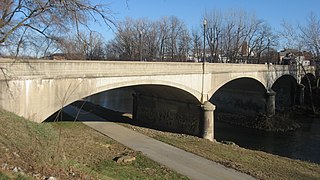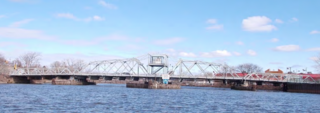
A truss bridge is a bridge whose load-bearing superstructure is composed of a truss, a structure of connected elements, usually forming triangular units. The connected elements may be stressed from tension, compression, or sometimes both in response to dynamic loads. The basic types of truss bridges shown in this article have simple designs which could be easily analyzed by 19th and early 20th-century engineers. A truss bridge is economical to construct because it uses materials efficiently.

The Hampden County Memorial Bridge is a reinforced-concrete arch bridge that spans the Connecticut River between Springfield, Massachusetts and West Springfield, Massachusetts, constructed in 1922. The bridge is owned by Massachusetts Highway Department and is located on Massachusetts Route 147. It spans 209 feet (64 m) and rises 29.71 feet (9.06 m) above the river.

The Hill to Hill Bridge is a road crossing of the Lehigh River and linking the south and north sides of Bethlehem, Pennsylvania in the Lehigh Valley region of the United States.

The Kettle Falls Bridges is the collective name for a pair of steel cantilever bridges carrying State Route 20/U.S. Route 395 and the Kettle Falls International Railway across the Columbia River at Kettle Falls, Washington. The south bridge carries motor vehicle traffic while the similar northern span is used for rail.

The West Washington Street Bridge is a historic concrete arch bridge in Muncie, Indiana, United States. It spans the White River, connecting Washington Street and Meeks Avenue. It was designed by Charles Armintrout, who was the Delaware County Engineer at the time. The bridge has four elliptical arch spans. The steel reinforcements of the arch rings extend deep into the bridge's piers and abutments, allowing the piers to be substantially thinner. This design was inspired by the works of Edwin Thacher. Although this bridge is made of concrete, a series of recessed panels, which have the aggregate exposed, provides texture and contrast.

Kingsland Avenue Bridge, earlier known as Avondale Bridge and designated the De Jessa Memorial Bridge, is a vehicular movable bridge over the Passaic River in northeastern New Jersey. It crosses the county line to connect the towns of Lyndhurst in Bergen and Nutley in Essex, originally taking its name from the Kingsland section. The bridge is 10.7 miles (17.2 km) from the river's mouth at Newark Bay, and is required to open on four hours' notice. As of 2010, there were 26,420 daily crossings of the bridge, which provides one lane in each direction.

The Court Street Bridge, also known as the Harold J. Dillard Memorial Bridge, is a vehicular movable bridge crossing the Hackensack River between Hackensack and Bogota in Bergen County, New Jersey, which owns it. Located 16.2 miles (26.1 km) from the river mouth at Newark Bay, the swing bridge, which opened in 1908 and underwent major rehabilitation in 2010–2012, is the most-upstream bridge on the river required by federal regulations to open on request.

Sadliers Crossing Railway Bridge is a heritage-listed railway bridge at over Bremer River between Tallon Street, Sadliers Crossing and Dixon Street, Wulkuraka, Queensland, Australia on the Main Line (this section is now the Ipswich and Rosewood railway line. It was added to the Queensland Heritage Register on 13 November 2008.

The Melan Bridge is located in Emma Sater Park on the east side of Rock Rapids, Iowa, United States. The 30-by-16-foot structure is believed to be the third reinforced concrete arch span built in the country. Austrian engineer Josef Melan developed a new system of concrete reinforcement for bridge construction in the early 1890s. A fellow Austrian, Fritz von Emperger, introduced the system in the United States, and obtained a patent for it in 1893.

The Ottauquechee River Bridge is a steel girder bridge carrying United States Route 5 across the Ottauquechee River in Hartland, Vermont. The bridge replaced a c. 1930 Warren deck truss bridge, built in the wake of Vermont's devastating 1927 floods, and listed on the National Register of Historic Places in 1990.
The Passaic Street Bridge is a vehicular bridge crossing the Passaic River in Passaic and Garfield, New Jersey. The girder bridge was built in 1898 and is the third to span the river at that point. It is considered eligible for listing on the New Jersey Register of Historic Places and National Register of Historic Places.

The Mississquoi River Bridge is a steel truss bridge, spanning the Missisquoi River between Richford, Vermont and Sutton, Quebec on the Canada–United States border. It connects Chemin de la Vallée Missisquoi in Sutton with Vermont Route 105A in Richford, between the border stations of the East Richford–Glen Sutton Border Crossing. The bridge was built by the state of Vermont in 1929, and is one of two in the state built by the Pittsburgh-Des Moines Steel Company. It was listed on the United States National Register of Historic Places in 1990.

The Straight Street Bridge is a vehicular bridge over the Passaic River in Paterson, New Jersey, that is listed on the National Register of Historic Places.

The Route 46 Passaic River Bridge can refer to a number of bridges that carry U.S. Route 46 (US 46) over the Passaic River in Northern New Jersey. US 46 was originally developed as Route 6 under the direction of Morris Goodkind who was chief engineer of the New Jersey Highway Department from 1922 until 1955.

Arch Street Bridge is Parker truss bridge over the Passaic River in Paterson, New Jersey. It was built in 1907 and rehabilitated in 1997. It was the third structure built at the location within a few years, the other having been destroyed by floods in 1902 and 1903. The bridge was once a crossing for the Public Service trolley lines.
Sixth Avenue Bridge, aka the North Sixth Street Bridge, is a pony truss vehicular bridge over the Passaic River in northeastern New Jersey. It connects the Bunker Hill neighbourhood of Paterson and Prospect Park at the border with Hawthorne via North Sixth Street. It was originally constructed 1907 as a steel structure supported on stone masonry piers and abutments and is one of several bridges built after the Passaic Flood of 1903. The older span opened was abruptly closed in 1986 after the Passaic County engineer at the time, Gaetano Fabrina, found that some steel beams had rusted and were "banging and clanging."

Monroe Street Bridge is bridge over the Passaic River in Passaic and Garfield, New Jersey. The 3-span reinforced concrete elliptical deck arch bridge was built in 1908. It was designed by Colin Wise and built by C.W. Dean and Company. It is 306 feet long and 30.2 feet wide.

Market Street Bridge, also known as the Second Street Bridge, is a vehicular bridge over the Passaic River crossing the Passaic-Bergen county line in Passaic and Wallington in northeastern New Jersey. The double-leaf bascule bridge was built in 1930 and fixed in the closed position in 1977. It was reconstructed in 2002. It carries a two-lane street and sidewalks in a late-19th and early-20th century industrial area along the river. An earlier structure built at the crossing in 1894 was damaged during the Passaic floods of 1902 and 1903 but survived.

The West Sixth Street Bridge is a historic stone arch bridge in downtown Austin, Texas. Built in 1887, the bridge is one of the state's oldest masonry arch bridges. It is located at the site of the first bridge in Austin, carrying Sixth Street across Shoal Creek to link the western and central parts of the old city. The bridge was added to the National Register of Historic Places in 2014.




















